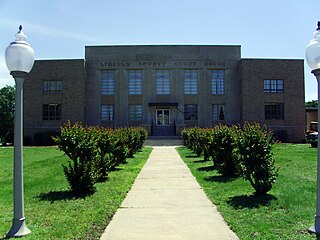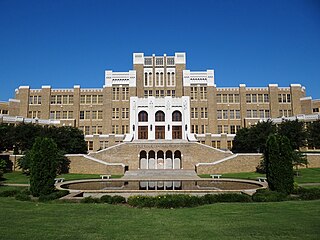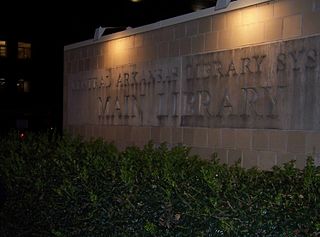
Arkansas is a state in the southern region of the United States, home to over 3 million people as of 2018. Its name is of Siouan derivation from the language of the Osage denoting their related kin, the Quapaw Indians. The state's diverse geography ranges from the mountainous regions of the Ozark and the Ouachita Mountains, which make up the U.S. Interior Highlands, to the densely forested land in the south known as the Arkansas Timberlands, to the eastern lowlands along the Mississippi River and the Arkansas Delta.

Washington County is a county located in the northwest part of the U.S. state of Arkansas. As of the 2010 census, the population was 203,065, making it the third-most populous county in Arkansas. The county seat is Fayetteville. It is Arkansas's 17th county, formed on October 17, 1828, and named for George Washington, the first President of the United States. Washington County is part of the Fayetteville-Springdale-Rogers, AR-MO Metropolitan Statistical Area.

Randolph County is located between the Ozark Mountains and Arkansas Delta in the U.S. state of Arkansas. The county is named for John Randolph, a U.S. senator from Virginia influential in obtaining congressional approval of the Louisiana Purchase, which includes today's Randolph County. Created as Arkansas's 32nd county on October 29, 1835, Randolph County has two incorporated cities, including Pocahontas, the county seat and most populous city. The county is also the site of numerous unincorporated communities and ghost towns.

Miller County is a county located in the southwestern corner of the U.S. state of Arkansas. As of the 2010 census, the population was 43,462. The county seat is Texarkana.

Lincoln County is located between the Arkansas Timberlands and Arkansas Delta in the U.S. state of Arkansas. It is also within the Pine Bluff metro area, and on the outer edge of the Central Arkansas region. The county is named for Abraham Lincoln, the 16th President of the United States. Created as Arkansas's 65th county on March 28, 1871, Lincoln County has three incorporated cities, including Star City, the county seat and most populous city. The county contains 46 unincorporated communities and ghost towns, Cane Creek State Park at the confluence of Cane Creek and Bayou Bartholomew, and nine listings on the National Register of Historic Places to preserve the history and culture of the county.

Hot Spring County is a county located in the U.S. state of Arkansas. As of the 2010 census, the population was 32,923. The county seat is Malvern. Hot Spring County was formed on November 2, 1829, from a portion of Clark County. It was named for the hot springs at Hot Springs, Arkansas, which were within its boundaries until Garland County was formed in 1874. It is an alcohol prohibition or dry county. However, there is no record of this law.

Conway is a city in the U.S. state of Arkansas and the county seat of Faulkner County, located in the state's most populous Metropolitan Statistical Area, Central Arkansas. Conway is unusual in that the majority of its residents do not commute out of the city to work. The city also serves as a regional shopping, educational, work, healthcare, sports, and cultural hub for Faulkner County and surrounding areas. Conway's growth can be attributed to its jobs in technology and higher education with its largest employers being Acxiom, the University of Central Arkansas, Hewlett Packard, Hendrix College, Insight Enterprises, and many technology start up companies. Conway is home to three post-secondary educational institutions, earning it the nickname "The City of Colleges".

Redfield is a small city in the Pine Bluff metropolitan area of northwestern Jefferson county in the U.S. state of Arkansas. The city is situated on the Union Pacific Railway and is approximately 24 miles (39 km) south of Little Rock, the state capital. As of the 2010 census, Redfield has a population of 1,297.

Lonoke is the second most populous city in Lonoke County, Arkansas, United States, and serves as its county seat. According to 2010 United States Census, the population of the city is 4,245. It is part of the Little Rock–North Little Rock–Conway Metropolitan Statistical Area.

John Netherland Heiskell was a prominent American newspaper editor who served briefly in the United States Senate after being appointed to fill a vacancy. He was the editor of the Arkansas Gazette from 1902 until his death, and served in the United States Senate from Arkansas briefly in 1913. As the result of his long life, Heiskell attained several Senate longevity records, and was the second U.S. Senator to reach the age of 100.

Little Rock Central High School (LRCHS) is an accredited comprehensive public high school in Little Rock, Arkansas, United States. The school was the site of forced desegregation in 1957 after the U.S. Supreme Court ruled that segregation of public schools was unconstitutional three years earlier. This was during the period of heightened activism in the Civil Rights Movement.
Central is located at the intersection of Daisy L. Gatson Bates Drive and Park Street.
Epperson v. Arkansas, 393 U.S. 97 (1968), was a United States Supreme Court case that invalidated an Arkansas statute that prohibited the teaching of human evolution in the public schools. The Court held that the First Amendment to the United States Constitution prohibits a state from requiring, in the words of the majority opinion, "that teaching and learning must be tailored to the principles or prohibitions of any religious sect or dogma." The Supreme Court declared the Arkansas statute unconstitutional because it violated the Establishment Clause of the First Amendment. After this decision, some jurisdictions passed laws that required the teaching of creation science alongside evolution when evolution was taught. These were also ruled unconstitutional by the Court in the 1987 case Edwards v. Aguillard.

The University of Arkansas at Little Rock is a metropolitan public research university located in Little Rock, Arkansas, United States. Established as Little Rock Junior College by the Little Rock School District in 1927, the institution became a private four-year university under the name Little Rock University in 1957. It returned to public status in 1969 when it merged with the University of Arkansas System under its present name.

The UA Little Rock William H. Bowen School of Law is a public law school, part of the University of Arkansas at Little Rock. The school is both American Bar Association (ABA) accredited and a member of the Association of American Law Schools (AALS).

Little Rock is the capital and most populous city of the U.S. state of Arkansas. It is also the county seat of Pulaski County. It was incorporated on November 7, 1831, on the south bank of the Arkansas River close to the state's geographic center. The city derives its name from a rock formation along the river, named the "Little Rock" by the French explorer Jean-Baptiste Bénard de la Harpe in the 1720s. The capital of the Arkansas Territory was moved to Little Rock from Arkansas Post in 1821. The city's population was 198,541 in 2016 according to the United States Census Bureau. The six-county Little Rock-North Little Rock-Conway, AR Metropolitan Statistical Area (MSA) is ranked 78th in terms of population in the United States with 738,344 residents according to the 2017 estimate by the United States Census Bureau.

The Little Rock Nine was a group of nine African American students enrolled in Little Rock Central High School in 1957. Their enrollment was followed by the Little Rock Crisis, in which the students were initially prevented from entering the racially segregated school by Orval Faubus, the Governor of Arkansas. They then attended after the intervention of President Dwight D. Eisenhower.

The following outline is provided as an overview of and topical guide to the U.S. state of Arkansas:

On May 17, 1954, the U.S Supreme Court ruled that racial segregation of public schools was unconstitutional in the United States. That ruling would focus the spotlight of national attention in the United States upon the Arkansas National Guard and the integration of Central High School. The Arkansas National Guard was drawn into the conflict when Governor Orval Faubus ordered them to "Preserve the Peace" by turning away the black students who were attempting to integrate into Little Rock's Central High School. President Dwight D. Eisenhower reacted to this use of the Guard to foil the court-ordered integration by federalizing the entire Arkansas National Guard and using it to protect the nine black students integrating Central High School.



















